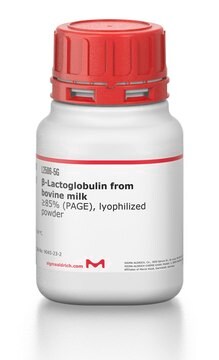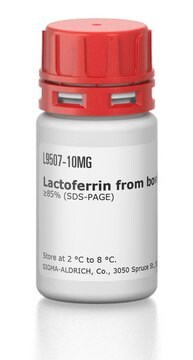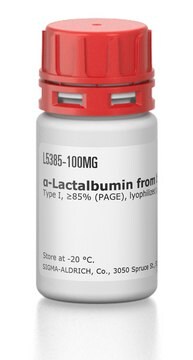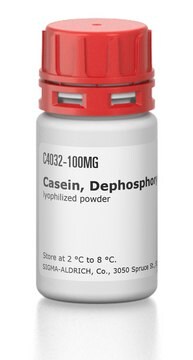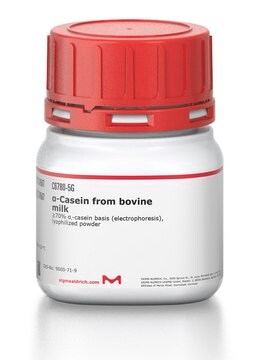L0130
β-Lactoglobulin from bovine milk
≥90% (PAGE), lyophilized powder
Synonym(s):
β-LG, Bos d 5, beta-LG
Sign Into View Organizational & Contract Pricing
All Photos(2)
About This Item
Recommended Products
biological source
bovine milk
Quality Level
Assay
≥90% (PAGE)
form
lyophilized powder
UniProt accession no.
storage temp.
2-8°C
Gene Information
bovine ... LGB(280838)
Looking for similar products? Visit Product Comparison Guide
General description
A member of the lipocalin family, β-Lactoglobulin (βLg) is a small protein of 162 amino acids with a molecular mass of ∼18,400 Da. It features an eight-stranded β-barrel (strands A-H) succeeded by a three-turn a-helix and a final β-strand (strand I) that forms part of the dimerization interface.
Milk from dairy cows contains the protein β-lactoglobulin (BLG). It naturally occurs in a number of genetic variants, and the most prevalent bovine variants are BLG A and BLG B.
Application
β-Lactoglobulin from bovine milk was used to test the allergen-responsive CD4+ CD25+ regulatory T cells in children who have outgrown cow′s milk allergy. It is also used to test the competitive displacement of β-lactoglobulin by Tween 20 from oil-water and air-water interfaces.
Other Notes
Contains β-lactoglobulins A and B which can be isolated chromatographically.
Quality
May not contain folate binding protein; not recommended for folate analysis.
Preparation Note
Crystallized
Storage Class Code
11 - Combustible Solids
WGK
WGK 3
Flash Point(F)
Not applicable
Flash Point(C)
Not applicable
Personal Protective Equipment
dust mask type N95 (US), Eyeshields, Gloves
Certificates of Analysis (COA)
Search for Certificates of Analysis (COA) by entering the products Lot/Batch Number. Lot and Batch Numbers can be found on a product’s label following the words ‘Lot’ or ‘Batch’.
Already Own This Product?
Find documentation for the products that you have recently purchased in the Document Library.
Customers Also Viewed
Janire Orcajo et al.
Analytica chimica acta, 1052, 163-169 (2019-01-28)
Immunochemical detection of food allergens is usually based on the use of polyclonal or monoclonal immunoglobulins G (IgG) antibodies. However, due to differences in epitopes recognition between IgG and IgE, an epitope modification during food processing can potentially alter allergenicity
The Competitive Displacement of ?-Lactoglobulin by Tween 20 from Oil-Water and Air-Water Interfaces
Peter J. Wilde, David C. Clark
Journal of Colloid and Interface Science, 155, 48-54 (1993)
Unni Haddeland et al.
Pediatric allergy and immunology : official publication of the European Society of Pediatric Allergy and Immunology, 16(2), 104-112 (2005-03-25)
The hygiene hypothesis implies that the increasing prevalence of allergy in 'westernized' countries is explained by reduced bacterial exposure in early life, but the underlying mechanism remains elusive. We therefore wanted to study the effect of bacterial lipopolysaccharide (LPS) on
A Heinzmann et al.
International archives of allergy and immunology, 120(4), 280-286 (2000-01-21)
beta-Lactoglobulin (BLG) represents one of the major allergens causing cow's milk allergy (CMA) - a disease with a wide spectrum of clinical symptoms. The aim of this study was to evaluate sequential B cell epitopes of BLG by the Pin-ELISA
Kristin R Domike et al.
International journal of biological macromolecules, 44(4), 301-310 (2009-05-14)
Proteins aggregated into spherulite structures of amyloid fibrils have been observed in patients with certain brain diseases such as Alzheimer's and Parkinson's. The conditions under which these protein spherulites form and grow are not currently known. In order to illuminate
Our team of scientists has experience in all areas of research including Life Science, Material Science, Chemical Synthesis, Chromatography, Analytical and many others.
Contact Technical Service



